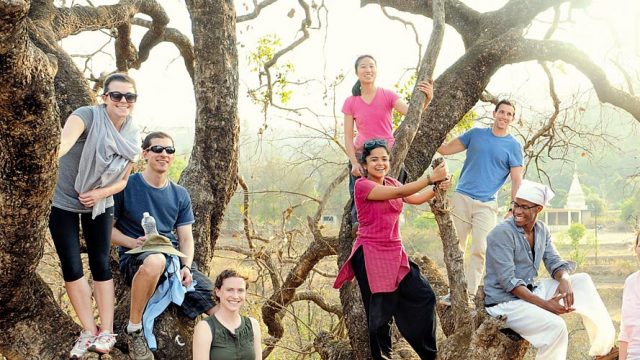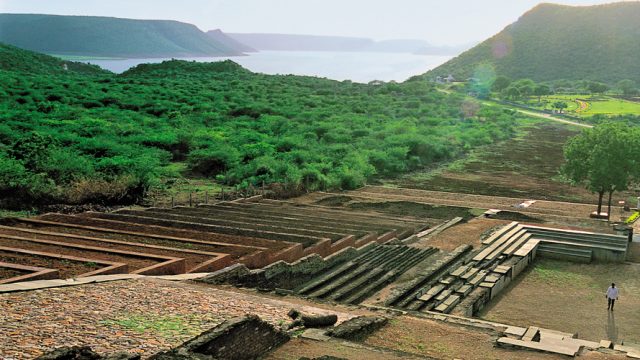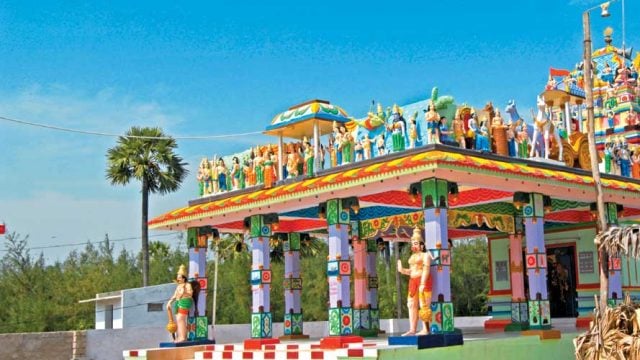As we sped along the road from Hyderabad towards Kurnool, my thoughts dwelled quite a bit on
The destination was Kurnool, the gateway to Rayalaseema – a province with a rich and varied history, a place of hot passions, of violent factionist loyalties, a land that was once the stronghold of Krishna Deva Raya. Rayalaseema and coastal Andhra together now get called ‘Seemandhra’ – two-thirds of the former whole.
Kurnool town received us indifferently. We settled into the hotel, and battered as we were from the hot drive, decided on a siesta first. Then, as the sun moved west, revived by cups of tea, we ventured first to the tomb of Abdul Wahab Khan, the first Nawab of Kurnool. The two domes were visible over rooftops from a distance, and narrow, winding roads led us there. No sooner had I stepped into the compound than I acquired the company of a band of inquisitive school boys, intrigued by visitors from far-off lands. We took a shine to one another and my friends accompanied me inside as I peered into the musty burial chambers of the noble family, then to an adjoining dargah and around the tomb to the Hundri River, now a murky trickle.
The tomb held no surprises, but I was utterly charmed by the building that abuts it. This was Osmania College, a privately run college that offers up to post-graduate degrees. I wandered into the grey, stone courtyard. Students were making their way home and activity for the day was winding down. Established in 1947 by the educationist Dr M Abdul Haq, this place exudes a combination of an old-world that keeps pace with the contemporary world, albeit in its own way. At many points, I saw, at a height above my own, markings declaring ‘Flood Level, 2009’. I knew there had been floods in Kurnool a few years ago, but it was still startling to realise that had I stood at this point then, I’d have been submerged with half a foot to spare.
I strolled into the library and was warmly made welcome by Mohd Akmal sa’ab, who has held charge here for 32 years. This reading room, he informed me, was inspired by the Connemara Public Library in Chennai. A long central reading table, afternoon light slanting on the bookshelves, small lime-washed staircases leading to the upper levels… I took in a breath of deep delight. Portraits of various dignitaries lined the walls, including one of Ghalib. And the issuing counter was such an anachronism, I had to have a picture of that as well.
But light was fading and I wanted to see the Konda Reddy Burz by decent light, so I tore myself away and rushed to the Old Bus Stand area. There, to one side of teeming traffic, was the semi-circular citadel. It is not a word one commonly applies to forts, but, I tell you, it fits this one: Konda Reddy Burz is cute. Dated to sometime around 1530-42 CE, it was built by Achyuta Raya, the successor of Krishna Deva Raya. It was used as a community call-to-arms, the man from the Archaeological Survey of India (ASI) told me; not living quarters, but a bolt-hole in case of attack. There is a boarded-up underground passage here that is said to lead all the way to Alampur, 28km to the northeast, to emerge somewhere in the precincts of the old Jogulamba Temple there. But the thrill of hearing about secret pathways like this one inevitably dims in the light of repressive realities. It has been sealed, they will tell you, the passage has been blocked by rubble and is unusable… and no, you certainly can’t explore it. Oh, what’s the use? This sort of thing would have never deterred children in adventure books, but I nod meekly and go away.
The next day, we took a winding route across the district to Belum Caves. Barely 25km out of Kurnool, however, we stopped to have our breath taken away. Let’s put it this way – there are rocks at Orvakallu. Lots of them. Magnificent deposits of quartz and silica piled up in spectacular formations. Between two tall walls of stone, there is a ravine that has been cut through by water. I’d been here before, but it was even more impressive the second time.
We rushed through breakfast and headed to Banganapalle. I didn’t have too much information about what I was seeking here – just a couple of references online. However, the picture I’d seen was enough to have me turn a touch dogged and enquire for the “Arundhati bangla?” at every halt for directions. What I was looking for was the summer residence of the Nawab Mir Fazl Ali Khan Bahadur, more recently famous for being the shoot-location of a Telugu fantasy thriller called Arundhati.
They told us we’d find it on the road to Yaganti, near the village of Pathapadu. And just when we began to have misgivings about this search, there it was under the torrid noon sun: on a slight hillock, somehow looking imposing, forlorn, forbidding and beckoning at once. A beautifully proportioned bangla with a series of arched windows, staircases leading up from each side. It looked deserted, but there were a couple of villagers in occupation after all. An array of local snacks was laid out and they collected a modest entry fee which opened the locked doors of the building. I bought a potnam of sunflower seeds for Rs 5 and followed the woman in. Corridors gave way to chambers. Here and there, the roof had caved in and sunlight streamed strongly in, making for nice pictures, but a sad story. I could see why Arundhati had chosen to come here – there were ghosts still.
Our next halt was Yaganti, which was famous for its temple to Shiva. Nestled at the foot of some imposing cliffs, the lord is called Yaganti Uma Maheshwara here. Built by the illustrious Sangama kings Harihara and Bukka Rayulu, the 15th-century temple is beautiful, with a pushkarni ever-supplied with spring water. And to one side of the main temple is a dramatic shrine. Steep steps lead up the cliff-side and right into a thin aperture in the rock… the cave opens up to considerable height and here, in an alcove, reigns Lord Venkateshwara, whom Sage Agastya first intended to install at Yaganti before Shiva took it for his own.
By now, we could see that stone was a ubiquitous feature of the Kurnool landscape. Untouched and towering in some spots, and fully exploited at others such as the village of Betamcherla, famous for its polished slab. Marble, granite, black stone are all mined here and almost every building we passed was in the stone business. But now, at Belum, we were approaching rock at another level altogether. At a length of 3,229m, these appear to be the longest cave systems in the country outside of the karsts of Meghalaya. The entrance was a circular pit and right away, we descended and then moved into a spacious chamber with a circular opening overhead. I craned my neck to see a deep blue sky and a white puff of cloud… at the rim of the crater, grass fluttered in the breeze… so pretty! That was our last glimpse of the sky for a while.
The Belum caves in Andhra Pradesh were first discovered by British surveyor Robert Bruce Foote in 1884, but it was only recently, in 1982-84, that a team of German speleologists headed by Daniel Gebauer conducted a detailed exploration of the caves. The team mapped about three and a half kilometres of caves, and when APTDC stepped in to develop the Belum caves as a tourist attraction in 2000, they put to use only a kilometre and a half. Knowing that this tourism corporation had great enthusiasm that was not equalled by good taste, I will admit to some apprehensions about their treatment and showcasing of natural wonders. Walking into the caves, I did purse my lips at an artificial fountain, did wonder if they needed to be quite so obtrusive in designing stairs and ramps for tourists. But after the whole tour, I have to tip my hat to them, and indeed thank them for making the experience of the Belum caves at all possible for people without endurance or a thirst for perilous adventure.
The whole walk has been designed to include various features of interest – large caverns, interesting formations and, at the lowest point at 120ft below, a spring they’ve called Patalaganga. It gets hot and it gets claustrophobic, so at four points during the walk, the authorities have lowered air shafts for people to stand under and, literally, recover their breath. The sense of being underground, surrounded by damp black limestone, running my finger along indentions made by water, seeing shapes formed by years of stress and deposit… it was simply terrific.
It was time to head back to Hyderabad, but there was time for one more detour – the temple complex at Alampur. Now this, strictly, isn’t in Kurnool – it falls within Mahbubnagar and, therefore, Telangana. On the other hand, history binds these places rather tightly. After all, when carts ferried stone to the temples being built at Alampur in the 7th century, it was at Kurnool that they stopped to be greased. Kandenavolu, they used to call it then, for ‘kandena’ meant grease.
The temple complex at Alampur is on the banks of the Tungabhadra and each shrine – there are many – has a tale to tell. I walked along here and there, and came upon a dargah wedged snugly into the wall next to a temple for the lady Kamakshi. India’s secularism pops up in the most unexpected nooks. Then I stopped at an ornate pathway when a priest fortuitously offered me information. The jyothirlinga at Srisailam had four gates in four directions, and this spot, where I now stood, was the western gateway – an entrance that has witnessed footfalls of every pilgrim that came from this direction.
The lie of the land was different then, I mused, their hubs were other than the ones we’ve created… the lines they drew on their maps were formed differently.
Kingdoms collapse, establishments fade away, lines blur and are redrawn afresh in each era… cities rise and fall, but the land is more enduring. These border lines don’t matter as much as I think they do.
The information
Getting there: Kurnool is 220km south of Hyderabad. By road, it is accessed by NH7 (now renamed NH44) in about 4hrs. It is 360km from Bengaluru, and takes about 5½ hrs via NH7 (NH44). Buses as well as trains are plentiful from both cities.
Where to stay: We stayed at the centrally-located DVR Mansion (from Rs 1,820 for doubles, breakfast complimentary; http://dvrmansion.com). Our rooms were fairly comfortable. In the vicinity is SV Regency (from Rs 1,800; http://svregency.com), which is well spoken of. Also consider APTDC’s Haritha Hotel (from Rs 775 for non-AC double; 8518252210, 9010177055; www.aptdc.gov.in/home.html), in Venkataramana Colony, which stands in a spacious garden. Outside Kurnool town, the Haritha chain has a series of properties, which make for nice perches to explore the district from. There are some cottages at Orvakallu (from Rs 800; 9912326085), and they have some rather basic accommodation near the Belum caves (call Kumar: 9705389600), where you can have the lone double room for Rs 350, or you can bunk down in the 6-bed dormitory for Rs 150 a bed. Alternatively, you could block the whole dorm for yourself for Rs 600.
Where to eat: In Kurnool town, Mint Leaf at the SBI Circle offers multi-cuisine fare. You should try their authentic ragi sankati that goes fabulously with natu kodi pulusu or country chicken gravy. Along the road, Jana Priya has a long menu and their biryani is rather good. Red Chillies, at Woodland Complex, has good things said about it as does Sasya Pride in the same area. There are several ‘darshinis’ around the town – you get lighter tiffins that you eat standing around tables. They’re excellent if you don’t mind speedy meals. Among street food delights, if you come across a bandi selling kova buns, do grab a few – I was sadly stuffed to the gills when I came across a vendor, but had to make room for this small bun sandwich with yummy kova or mava filling. For snacks on the drive, we stopped at bakeries dotting the towns for murukku and shankarapalli, which is crispy maida biscuit, dipped in sugar syrup.
What to see & do: Gol Gumbaz is the mausoleum of Abdul Wahab Khan, the first Nawab of Kurnool. Located next to Osmania College, on the banks of the Hundri River, this tomb has recently received a facelift and a lick of paint. The terraces are closed to visitors and cameras are not allowed inside. In the heart of the town, Konda Reddy Burz is an endearing little fort. Entry is free and it is open from sunrise to sunset.
Twenty-five kilometres from Kurnool, Orvakallu is a stunning place with immense, sprawling rock formations with millennia-worth deposits of silica and quartz. You’ll also be tickled by a quaint outdoor art display that APTDC has created here, along the 1km walk among the rocks: some very neat sculptures made of salvage material.
The former princely state of Banganapalle is better known for its mangoes, but the dilapidated yet highly atmospheric summer home of a former Nawab is well worth a visit. If the caretaker is around, an entry fee of Rs 5 gives access to the inner rooms.
The Uma Maheshwara Temple at Yaganti is a shrine to Shiva and attracts thousands of devotees on Mahashivarathri every year. A cave temple to Lord Venkateshwara is embedded in the cliff-side and you must also climb up to Shankara Guha, an alcove used by the 17th-century saint and seer Veerabrahmendra Swamy.
For an unforgettable experience of a subterranean world, the Belum caves (Rs 50 for Indians, Rs 300 for foreign nationals; 10am-5pm, entry not allowed after 4pm) must go on your list of must-visits in Andhra Pradesh. The 1.5km walk includes many features: the lofty Simhadwaram, Kotilingalu and, at 120ft below the surface, a spring called Patalaganga.
The ancient city of Alampur is the meeting point of the rivers Tungabhadra and Krishna and has a temple complex comprising many shrines. The goddess is worshipped here as Jogulamba and the site is one of the subcontinent’s 51 Shakti Peethas. Also notable is the temple to Bala Brahmeswara Swamy, a form of Shiva. There is an interesting little archaeological museum here (Rs 10; 10.30am-5pm).
Kurnool
Rayalaseema
Seemandhra





